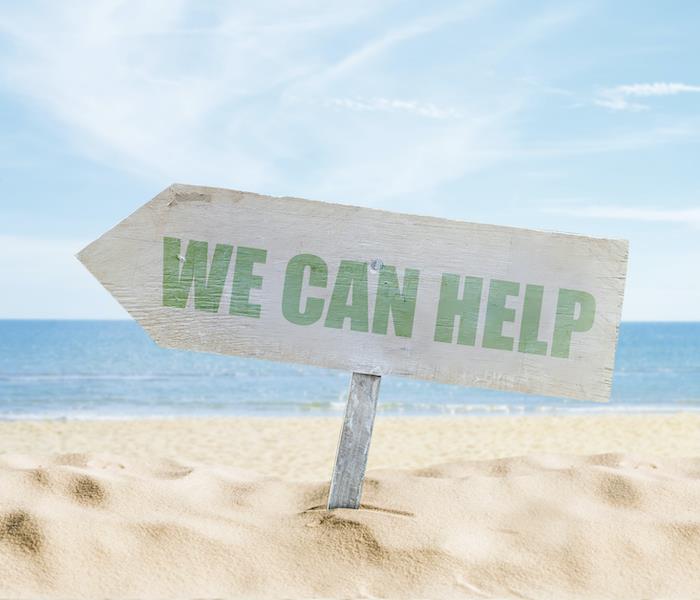How Do Professionals Repair Water Damage to Floors in Cocoa?
7/29/2020 (Permalink)
 Let us help you get your Cocoa home back in order after a devastation occurs. Give us a call at (321) 638-4947. We are available 24/7.
Let us help you get your Cocoa home back in order after a devastation occurs. Give us a call at (321) 638-4947. We are available 24/7.
SERVPRO Technicians Pair Water Damage Repair Strategies with the Different Flooring Materials Found in Cocoa Residences.
It is the nature of fluids to flow to the lowest level open to them, so the floors in your Cocoa home require thorough inspection and special attention after a water loss. There is no overt “competition” among the various structural components in your home in terms of the most significant water damage. Still, floors are crucial to every function and the structural integrity of your dwelling. Our managers and technicians are trained through coursework and hands-on experience developed by the Institute of Inspection, Cleaning and Restoration Certification (IICRC). Our understanding of the different strategies and their applications needed to repair various types of flooring is robust.
What Can I Expect the Prognosis to Be for Wet Laminate Flooring?
Successful water damage repair for your Cocoa laminated floors is not possible in many cases. This engineered-type flooring might resemble a more durable material like hardwood or stone, but it is a multi-layer product made of:
- A foundation layer of melamine backer.
- An intermediate layer of medium or high-density fiberboard (MDF or HDF) -- softwood fibers mixed with wax and resin, formed into strips or panels using heat and pressure.
- Visual layer -- a high-resolution image of wood or other material the flooring replicates.
- Topcoat -- resin and cellulose, sometimes textured the match the grain or pattern of the visual.
Occasional spills quickly removed are not a problem with this type of flooring. When the materials become soaked, however, the layers peel apart, and this delamination ruins the floor. Removal and replacement are the norm.
What Approaches Are Used to Repair Water Damage to Hard Flooring?
SERVPRO inspects the many spaces in your home, looking at each floor’s material to determine what interventions are most appropriate to mitigate and repair any harm done by water. Concrete floors, with and without overlying tiles, present different challenges than ceramic tiles installed over a wood-product subfloor.
What Are the Concerns with Concrete Floors?
Concrete floors are porous but generally hold up well when water removal and structural drying completes. Complications are common but usually minor, but include:
- Paint on concrete can dislodge and need repainting -- lead paint issues need ruling out or management by a certified contractor.
- White, chalky residues can rise to the surface as calcium is in the concrete mix -- cleaning resolves.
What Changes if Asphalt or Vinyl Tiles Cover the Concrete?
Resilient tiles applied over concrete provide some cushioning (resilience) and decorative effect but can make water damage repair more involved. (See above for laminate flooring installed over concrete.)
- Asphalt tiles weather the damage well in most cases, but can exude a whitening from glues or the underlying floor, similar to an unadorned concrete floor -- cleanup is usually straightforward.
- Vinyl tiles loosen more easily, especially if the water moved over the surface or stood long enough to begin dissolving adhesives -- removal and replacement is the most common repair.
How Are Ceramic Floors Affected and What Is the Fix if Damaged?
It might come as a shock that ceramic floors are not always impervious to water damage. After all, they are installed in spaces designed to withstand regular water incursions, such as bathrooms, spas, and kitchens. Unfortunately, sometimes water does intrude due to:
- Cracks in the grout.
- Dried out or improperly applied caulking.
- Cracks in a tile due to blunt force damage.
When water percolates through a crack or crevice, it saturates the subfloor, causing swelling and distortion. Tiles can dislodge, odors can develop, and mold can take hold. Close inspection should reveal the areas of the incursion. Water removal and structural drying repairs the situation, although we might need to:
- Remove some tiles to provide access for water extraction and air movement.
- Dry from below, if possible.
- Drill holes to permit suction and aid in circulating warm, dry air before replacing tiles and regrouting and sealing.
Can Hardwood Floors Be Repaired Successfully After Water Damage?
Hardwood floors are more durable than commonly thought, especially if professionals remove the water involved fast. They also must retain appropriate moisture content, around 10 percent nationwide, although there are slight regional variants. Any more moisture, especially water that moved into the subfloor, present for an extended period, can distort the planks or strips:
- Cupping -- when water held in the subfloor wicks up and the edges of each plank or strip swell and push up.
- Crowning -- when the swelling concentrates in the center of the board, often a result of overdrying.
- Buckling -- when the damage is severe enough to cause the joints in a board line to break apart, and the hardwood pulls up the fasteners.
Professionals can reverse slight warping if swift and efficient water removal followed by drying occurs. Special floor mats connected to truck-mounted extractors are useful in pulling water from several layers. Air movers and dehumidifiers hasten to dry to appropriate levels.
Count on the professionals at SERVPRO of Central Brevard to save your floors after all degrees and severity of water damage. Contact us at (321) 638-4947 to schedule an assessment and planning session.

 24/7 Emergency Service
24/7 Emergency Service